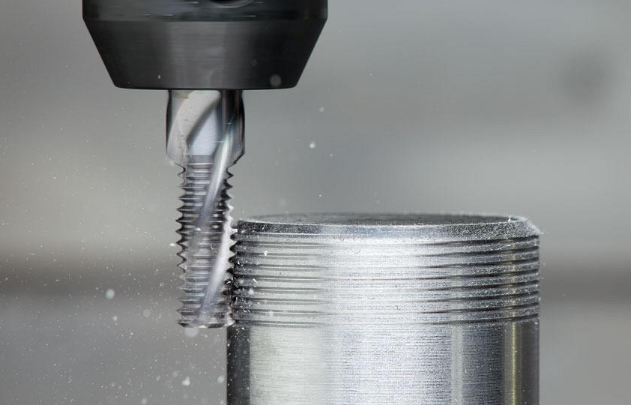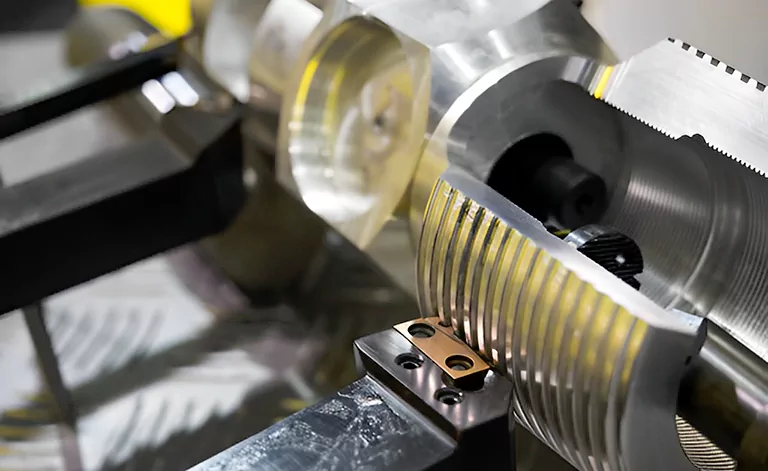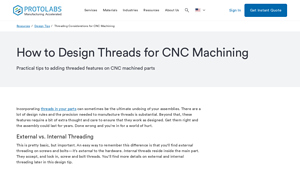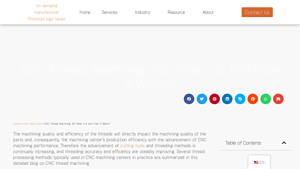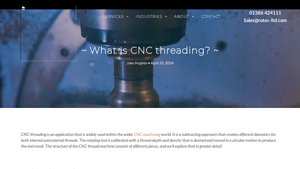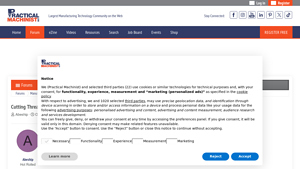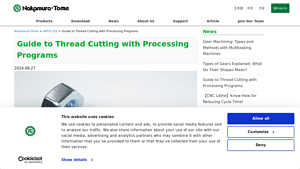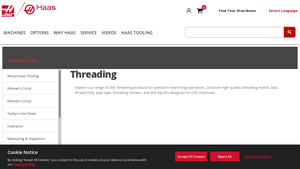Cnc Threading Guide: Type, Cost, Top List…
Introduction: Navigating the Global Market for cnc threading
In the complex landscape of global manufacturing, sourcing precision components like CNC threaded parts can pose significant challenges for B2B buyers. With a myriad of thread types, specifications, and machining techniques, the risk of misalignment between design expectations and manufacturing capabilities is high. This guide on CNC threading is designed to demystify the process, providing valuable insights into various thread types, their applications, and the intricacies of successful sourcing.
Within these pages, you will discover a comprehensive overview of external and internal threading, thread pitch considerations, and the critical importance of accurate design specifications. We will explore the best practices for supplier vetting, helping you identify reliable partners who can deliver quality products that meet your exact requirements. Additionally, cost factors and pricing strategies will be addressed, ensuring you are equipped to make informed financial decisions.
This guide is tailored for international B2B buyers, particularly those operating in emerging markets across Africa, South America, and the Middle East, as well as established players in Europe, including Germany and Saudi Arabia. By providing actionable insights and expert advice, we aim to empower you to navigate the global market for CNC threading with confidence, ultimately enhancing your procurement strategy and product quality.
Understanding cnc threading Types and Variations
| Type Name | Key Distinguishing Features | Primary B2B Applications | Brief Pros & Cons for Buyers |
|---|---|---|---|
| External Threading | Threads on the outer surface of components like screws and bolts | Machinery assembly, automotive parts | Pros: Easy assembly, strong grip; Cons: Requires precise machining to avoid misalignment. |
| Internal Threading | Threads located inside a component, accepting screws/bolts | Enclosures, fixtures, and fasteners | Pros: Space-saving, allows for compact designs; Cons: More complex machining process. |
| Unified Thread Series (UTS) | Includes UNC, UNF, and UNEF threads, varying in pitch | General manufacturing, automotive, aerospace | Pros: Standardized sizes facilitate compatibility; Cons: Limited options for custom applications. |
| Metric Threading | Based on the International System of Units (SI) | Electronics, machinery, consumer goods | Pros: Global standardization; Cons: May not fit with imperial systems without adapters. |
| Tapered Threading | Threads that taper along their length for specific applications | Oil and gas, plumbing, aerospace | Pros: Provides a tight seal, ideal for fluid applications; Cons: More complex to manufacture, higher cost. |
What Are the Key Characteristics of External Threading?
External threading is primarily characterized by threads that are cut on the exterior of a cylindrical part, such as screws and bolts. This type of threading is essential in applications where components need to be fastened together securely. It is widely used in various industries, including machinery assembly and automotive manufacturing. When considering external threading, buyers should focus on the precision of the thread profile and the material compatibility to ensure a strong and reliable connection.
How Does Internal Threading Differ and What Are Its Applications?
Internal threading involves creating threads within a component, allowing for the insertion of screws or bolts. This method is commonly used in enclosures, fixtures, and fasteners. Internal threads can save space and contribute to a more compact design, making them suitable for applications in electronics and machinery. However, the complexity of the machining process requires careful consideration of the thread depth and diameter to ensure proper fit and function.
What Are the Advantages of Using the Unified Thread Series (UTS)?
The Unified Thread Series (UTS) includes various thread types such as UNC, UNF, and UNEF, distinguished by their pitch and diameter. This standardization is beneficial for manufacturers, as it ensures compatibility across different components and assemblies. UTS is prevalent in general manufacturing, automotive, and aerospace industries. Buyers should consider the specific requirements of their applications to select the appropriate thread type, balancing factors like strength and assembly ease.
Why Choose Metric Threading for Global Applications?
Metric threading is based on the International System of Units (SI) and is widely adopted around the globe. Its standardization facilitates international trade, particularly in industries such as electronics and consumer goods. Buyers looking to source components should ensure they understand the metric specifications to avoid compatibility issues with other systems. While metric threading offers consistency, it may require adapters when interfacing with imperial systems.
What Are the Unique Features of Tapered Threading?
Tapered threading is characterized by threads that gradually decrease in diameter along their length, which allows for a tighter seal in applications where fluid containment is critical, such as in oil and gas or plumbing systems. The manufacturing process is more complex, which can lead to higher costs. Buyers should weigh the benefits of enhanced sealing against the potential for increased production expenses, particularly in high-volume applications.
Key Industrial Applications of cnc threading
| Industry/Sector | Specific Application of CNC Threading | Value/Benefit for the Business | Key Sourcing Considerations for this Application |
|---|---|---|---|
| Automotive | Production of threaded components for engines | Ensures precision and reliability in high-performance applications | Need for materials that withstand high temperatures and pressures; compliance with automotive standards |
| Oil & Gas | Manufacturing of threaded pipes and fittings | Enhances safety and durability in extreme environments | Sourcing from suppliers with certifications for high-pressure applications; understanding regional regulations |
| Aerospace | Creation of specialized fasteners for aircraft | Reduces weight while maintaining structural integrity | High precision requirements; sourcing from certified aerospace manufacturers; adherence to strict quality controls |
| Construction | Fabrication of threaded anchors and bolts | Improves structural stability and safety in building projects | Availability of materials that comply with local building codes; consideration of environmental factors in sourcing |
| Medical Devices | Production of threaded components for surgical instruments | Ensures safety and reliability in critical applications | Sourcing from suppliers with ISO certifications; understanding of biocompatibility requirements for materials |
How is CNC Threading Used in the Automotive Industry?
CNC threading plays a crucial role in the automotive sector, particularly in the production of threaded components for engines and other critical systems. These components, such as bolts and nuts, require high precision to ensure they function effectively under extreme conditions. The use of CNC threading mitigates issues related to misalignment and wear, ultimately enhancing the longevity and performance of automotive parts. International buyers must prioritize sourcing from manufacturers that adhere to automotive industry standards and can provide materials capable of withstanding high temperatures and pressures.
What are the Applications of CNC Threading in Oil & Gas?
In the oil and gas industry, CNC threading is essential for the manufacturing of threaded pipes and fittings that connect various components of drilling and extraction equipment. The precision of CNC threading ensures that these connections can withstand high pressures and corrosive environments, significantly reducing the risk of leaks and failures. Buyers in this sector should consider suppliers who have certifications for high-pressure applications and a solid understanding of regional regulations, especially in emerging markets in Africa and South America.
How Does CNC Threading Benefit the Aerospace Sector?
CNC threading is utilized in the aerospace industry for creating specialized fasteners that are lightweight yet robust enough to meet stringent safety standards. These fasteners are critical for assembling aircraft components, where even minor deviations can have significant repercussions. Buyers should seek suppliers with aerospace certifications, as well as those that can guarantee high precision and quality control throughout the manufacturing process. Understanding the specific thread standards and materials used in aerospace applications is vital for successful sourcing.
What Role Does CNC Threading Play in Construction?
In construction, CNC threading is applied in the fabrication of threaded anchors and bolts that secure structural elements. The precision of CNC threading enhances the stability and safety of buildings and infrastructure projects. Buyers must ensure that sourced materials comply with local building codes and standards, as well as consider environmental factors such as seismic activity in their sourcing decisions. Collaborating with suppliers who understand these requirements can lead to more successful project outcomes.
Why is CNC Threading Important for Medical Devices?
CNC threading is integral to the production of threaded components in medical devices, such as surgical instruments and implants. The precision required in this sector is paramount to ensure the safety and reliability of devices used in critical medical procedures. International buyers should focus on sourcing from suppliers with ISO certifications and a strong understanding of biocompatibility requirements for materials. This attention to detail is essential to meet the high standards of the medical industry and ensure patient safety.
3 Common User Pain Points for ‘cnc threading’ & Their Solutions
Scenario 1: Misalignment of Thread Specifications Leading to Assembly Issues
The Problem: One of the most common pain points for B2B buyers is the misalignment of thread specifications during the design and manufacturing process. Buyers often encounter situations where the threads on components do not match, leading to assembly failures. This can happen due to incorrect assumptions about thread types, such as mixing metric and imperial systems, or failing to account for variations in thread pitch and depth. These discrepancies can result in costly delays, wasted materials, and rework, ultimately affecting project timelines and budgets.
The Solution: To mitigate this issue, B2B buyers should prioritize clear and precise communication of thread specifications in their design documentation. When collaborating with manufacturers, ensure that you specify whether you require metric or imperial threads, and provide detailed information about thread pitch, depth, and tolerances. Utilizing CAD software that includes threading wizards can help automate and validate these specifications. Additionally, always request a prototype or sample of the threaded components before full-scale production. This will allow you to verify that the threads align correctly and function as intended, preventing assembly issues down the line.
Scenario 2: Inadequate Thread Depth Compromising Structural Integrity
The Problem: Another significant challenge arises when the threaded holes are not machined to the correct depth. Insufficient thread depth can lead to weak connections, making the final assembly prone to failure under stress. This is particularly critical in industries such as aerospace and automotive, where safety and reliability are paramount. Buyers often face the dilemma of balancing design constraints with the need for adequate thread engagement, resulting in compromised structural integrity.
The Solution: To address this concern, it’s essential to work closely with your CNC machining partner to establish acceptable thread depth parameters early in the design phase. Implement best practices such as specifying a minimum engagement length for threaded connections based on the material and application requirements. Additionally, conduct a thorough review of the tooling capabilities of your machining partner to ensure they can achieve the required thread depths. Consider using finite element analysis (FEA) during the design process to simulate the performance of threaded connections under load, allowing for informed decisions on thread depth and engagement.
Scenario 3: Difficulty in Accessing Internal Threading in Complex Designs
The Problem: Complex geometries can pose a significant challenge when it comes to internal threading. B2B buyers often find themselves dealing with designs that include internal threads in hard-to-reach locations, which complicates the machining process. This can lead to incomplete threading, cross-threading, or even damage to the component during manufacturing. Such issues can stall production and lead to increased costs due to rework or scrap.
The Solution: To overcome this challenge, it is crucial to design parts with manufacturability in mind. Engage with your CNC machining provider during the design phase to discuss potential complications associated with internal threading. Utilize design analysis software to evaluate accessibility for threading tools and adjust your designs accordingly. For instance, consider specifying access holes or adjusting the orientation of internal threads to facilitate easier machining. Additionally, ensure that the CNC provider has the right tooling and capabilities to handle complex internal threading requirements, such as using specialized threading tools or multi-axis machining techniques. By proactively addressing accessibility issues, you can streamline the manufacturing process and reduce the likelihood of errors.
Strategic Material Selection Guide for cnc threading
What Are the Key Properties of Common Materials for CNC Threading?
When selecting materials for CNC threading, it is crucial to consider their properties, as they directly influence the performance and durability of the final product. Here, we analyze four common materials used in CNC threading: Aluminum, Stainless Steel, Brass, and Carbon Steel.
How Does Aluminum Perform in CNC Threading Applications?
Aluminum is a lightweight material known for its excellent machinability and corrosion resistance. It typically performs well under moderate temperature and pressure conditions, making it suitable for various applications, including automotive and aerospace components. The primary advantage of aluminum is its low density, which reduces overall weight without compromising strength.
However, aluminum threads can be less durable than those made from harder materials, particularly under high-stress conditions. Additionally, while aluminum is generally cost-effective, its price can fluctuate based on market conditions. For international buyers, especially in regions like Europe and the Middle East, compliance with standards such as ASTM and DIN is essential to ensure quality and compatibility.
What Are the Benefits and Limitations of Stainless Steel for CNC Threading?
Stainless steel is renowned for its exceptional corrosion resistance and strength, making it a preferred choice for applications exposed to harsh environments, such as marine or chemical processing. It can withstand high temperatures and pressures, ensuring longevity in demanding applications.
On the downside, stainless steel can be more challenging to machine compared to softer metals, leading to increased manufacturing complexity and costs. It also requires specific tooling and techniques to achieve precise threads, which may not be readily available in all regions. For buyers in Africa and South America, understanding local machining capabilities and standards is vital when considering stainless steel for CNC threading.
Why Is Brass a Popular Choice for CNC Threading?
Brass is favored for its excellent machinability and good corrosion resistance, particularly in plumbing and electrical applications. It provides a good balance between strength and ductility, making it suitable for threaded fittings and connectors. Brass threads are known for their smooth finish and excellent sealing properties.
However, brass can be more expensive than aluminum and may not be suitable for high-stress applications due to its lower tensile strength. Additionally, international buyers should be aware of the varying standards for brass alloys and ensure compliance with local regulations, especially in markets like Germany and Saudi Arabia.
What Role Does Carbon Steel Play in CNC Threading?
Carbon steel is a versatile material known for its high strength and durability, making it suitable for heavy-duty applications. It can be heat-treated to enhance its properties, allowing it to withstand significant stress and wear. Carbon steel threads are commonly used in construction, automotive, and machinery applications.
The main drawback of carbon steel is its susceptibility to corrosion if not properly treated or coated. This can limit its use in environments exposed to moisture or chemicals. For international buyers, understanding the specific grades of carbon steel and their compliance with standards like JIS and ASTM is crucial for ensuring product reliability.
Summary Table of Material Selection for CNC Threading
| Material | Typical Use Case for CNC Threading | Key Advantage | Key Disadvantage/Limitation | Relative Cost (Low/Med/High) |
|---|---|---|---|---|
| Aluminum | Automotive and aerospace components | Lightweight and corrosion-resistant | Less durable under high stress | Low |
| Stainless Steel | Marine and chemical processing applications | Exceptional corrosion resistance | Higher manufacturing complexity | High |
| Brass | Plumbing and electrical fittings | Excellent machinability and sealing | More expensive and lower tensile strength | Medium |
| Carbon Steel | Heavy-duty construction and machinery | High strength and durability | Susceptible to corrosion | Medium |
This guide provides a comprehensive overview of material options for CNC threading, helping international B2B buyers make informed decisions based on their specific needs and regional standards.
In-depth Look: Manufacturing Processes and Quality Assurance for cnc threading
What Are the Main Stages of CNC Threading Manufacturing Processes?
The manufacturing of CNC threaded components is a meticulous process that involves several key stages, each critical to ensuring the final product meets the required specifications. The main stages typically include material preparation, forming, assembly, and finishing.
How Is Material Prepared for CNC Threading?
Material preparation is the foundational step in CNC threading. It involves selecting the appropriate material based on the application requirements, such as tensile strength, corrosion resistance, and machinability. Common materials include stainless steel, aluminum, and various alloys. Once the material is selected, it is cut to size and checked for any defects.
After sizing, the material often undergoes a surface treatment, such as cleaning or coating, to remove any contaminants that could affect the machining process. This step is crucial as it ensures the integrity of the threading operation and minimizes wear on cutting tools.
What Techniques Are Used in the Forming Stage of CNC Threading?
Forming is the stage where the actual threading takes place. CNC machines, equipped with advanced software, utilize various techniques to create precise threads. The most common methods include:
-
Turning with G76 Cycle: This method employs the G76 command to cut threads on CNC lathes. It allows for detailed control over thread dimensions, pitch, and depth, which is essential for achieving high precision in both internal and external threads.
-
Tapping: This process involves using a tap to create internal threads. It requires careful consideration of pilot hole dimensions and tap selection to prevent cross-threading and ensure a secure fit.
-
Milling: For more complex thread profiles, CNC milling can be used. This method allows for the creation of non-standard threads and can accommodate a variety of geometries, enhancing design flexibility.
Each technique has its advantages, and the choice often depends on the specific requirements of the project, including thread type, material, and production volume.
How Is Assembly Managed in CNC Threading?
In the assembly stage, threaded components are integrated into larger assemblies, which may involve fitting bolts, screws, or other fasteners. Precision in this stage is paramount to avoid issues like misalignment or inadequate fastening.
Assembly often includes several checks, such as verifying that all threaded components fit together as intended. Any discrepancies can lead to assembly failures, which can be costly in terms of both time and resources.
What Quality Control Measures Are Essential for CNC Threading?
Quality control (QC) is a critical aspect of CNC threading, ensuring that the manufactured parts meet international and industry-specific standards. Implementing robust QC measures helps maintain product consistency and reliability.
Which International Standards Apply to CNC Threading?
B2B buyers should be aware of several international standards that govern quality assurance in CNC threading:
-
ISO 9001: This is a widely recognized standard for quality management systems (QMS). It emphasizes a process-oriented approach and continuous improvement, ensuring that organizations meet customer and regulatory requirements.
-
CE Marking: This certification indicates that products conform to health, safety, and environmental protection standards within the European Economic Area. It is crucial for suppliers targeting European markets.
-
API Standards: For industries like oil and gas, adherence to American Petroleum Institute (API) standards is essential. These standards ensure that components are fit for purpose and can withstand operational stresses.
What Are the Key QC Checkpoints in CNC Threading?
Quality checkpoints during the manufacturing process are vital to maintaining high standards. Common QC checkpoints include:
-
Incoming Quality Control (IQC): This involves inspecting raw materials upon arrival to ensure they meet specified standards before processing begins.
-
In-Process Quality Control (IPQC): During manufacturing, periodic checks are conducted to monitor critical dimensions and tolerances. This step ensures that any deviations are caught early, reducing waste and rework.
-
Final Quality Control (FQC): After machining is complete, a comprehensive inspection is performed. This includes dimensional verification, surface finish assessment, and functional testing of threaded components.
How Can B2B Buyers Verify Supplier Quality Control?
When sourcing CNC threaded components, B2B buyers must be proactive in verifying supplier QC practices. Here are several strategies:
-
Supplier Audits: Conducting on-site audits allows buyers to assess the manufacturing processes and quality management systems in place. This firsthand insight can provide confidence in the supplier’s capabilities.
-
Requesting Quality Reports: Suppliers should be willing to provide documentation of their QC processes, including inspection results and compliance certifications. Reviewing these reports can highlight the supplier’s commitment to quality.
-
Third-Party Inspections: Engaging independent inspection agencies can provide an unbiased evaluation of the supplier’s quality practices. This is particularly valuable for buyers in regions where local oversight may be limited.
What Are the QC and Certification Nuances for International B2B Buyers?
International buyers, especially those from Africa, South America, the Middle East, and Europe, should be aware of specific nuances in QC and certification processes:
-
Cultural and Regulatory Differences: Different regions may have varying expectations regarding quality standards and certifications. Understanding these differences is crucial for successful international partnerships.
-
Logistics and Supply Chain Considerations: Long shipping times and customs regulations can impact product quality upon arrival. Buyers should ensure that suppliers have robust packaging and handling procedures to mitigate potential damage during transit.
-
Communication and Documentation: Clear communication regarding quality expectations and detailed documentation are essential for preventing misunderstandings. Buyers should establish clear lines of communication with suppliers to facilitate smooth transactions.
By understanding these manufacturing processes and quality assurance measures, B2B buyers can make informed decisions when sourcing CNC threaded components, ensuring they receive high-quality products that meet their specific needs.
Practical Sourcing Guide: A Step-by-Step Checklist for ‘cnc threading’
Introduction
In the competitive landscape of CNC machining, sourcing threaded components requires precision and careful consideration. This guide provides a structured checklist for international B2B buyers seeking to procure CNC threading services. By following these steps, you will ensure that your threading needs are met with the highest quality and efficiency.
Step 1: Define Your Technical Specifications
Clearly outline the technical requirements for your threading project, including dimensions, thread type (internal or external), and material specifications. This step is crucial as it forms the foundation for communicating your needs to potential suppliers. Ensure you specify the thread pitch and depth, as these factors significantly influence manufacturing capabilities.
Step 2: Research Potential Suppliers
Conduct thorough research to identify suppliers specializing in CNC threading. Look for companies with a strong reputation in the market and experience in your specific industry. Utilize platforms like industry directories, trade shows, and online reviews to gather information on their performance and capabilities.
Step 3: Evaluate Supplier Certifications
Before proceeding, verify that potential suppliers hold relevant certifications, such as ISO 9001 for quality management systems. Certifications indicate a commitment to quality and adherence to industry standards. Ensure they have experience with the specific materials and processes required for your threading needs.
Step 4: Request Detailed Quotes
Obtain detailed quotes from shortlisted suppliers, ensuring they include all relevant costs, lead times, and payment terms. A comprehensive quote allows for better comparison between suppliers. Look for transparency in pricing, as hidden costs can significantly impact your budget.
Step 5: Assess Technical Capabilities
Evaluate the technical capabilities of each supplier. Inquire about their machining equipment, software, and threading techniques, such as the use of G76 threading cycles. Understanding their technology will help you gauge their ability to meet your specifications accurately and efficiently.
Step 6: Review Quality Assurance Processes
Examine the quality assurance processes employed by potential suppliers. Ask about their inspection methods, testing protocols, and how they handle defects or non-conformance issues. A robust quality assurance program is essential for ensuring that the threaded components meet your standards and function as intended.
Step 7: Check References and Case Studies
Request references and case studies from suppliers to gain insights into their past performance. Speaking with previous clients can provide valuable information regarding their reliability, communication, and ability to meet deadlines. Look for suppliers that have successfully delivered similar projects, particularly in your industry or region.
By following this checklist, B2B buyers can confidently navigate the sourcing process for CNC threading services, ensuring a smooth and successful procurement experience.
Comprehensive Cost and Pricing Analysis for cnc threading Sourcing
What Are the Key Cost Components in CNC Threading?
When sourcing CNC threading services, understanding the cost structure is crucial for effective budgeting. The primary cost components include materials, labor, manufacturing overhead, tooling, quality control (QC), logistics, and profit margins.
Materials represent a significant portion of the costs, particularly if high-strength alloys or specialized materials are required for specific applications. The choice of material impacts both the threading process and the final product’s performance.
Labor costs can vary widely based on the complexity of the threading operation and the skill level required. Skilled machinists are essential for precision threading, especially for intricate designs or high tolerances.
Manufacturing overhead includes expenses such as utilities, equipment maintenance, and facility costs. These costs are often distributed across multiple projects, impacting the per-unit cost of CNC threaded parts.
Tooling expenses arise from the need for specialized tools and fixtures to produce threads accurately. The initial investment in tooling can be significant, particularly for custom projects.
Quality Control (QC) processes are essential to ensure that threaded parts meet specified tolerances and standards. These costs may include testing, inspection, and certification, which are particularly important for industries like aerospace and automotive.
Logistics costs encompass transportation, warehousing, and handling, which can add to the overall expense, especially for international shipping.
Margins reflect the profit that suppliers add to their costs. These can vary based on market conditions, competition, and the supplier’s operational efficiency.
What Influences Pricing in CNC Threading?
Several factors affect the pricing of CNC threading services, which buyers should consider when negotiating contracts.
Volume and Minimum Order Quantity (MOQ) play a critical role in pricing. Larger orders often lead to lower per-unit costs due to economies of scale, while smaller quantities may incur higher costs due to setup and labor inefficiencies.
Specifications and Customization can significantly impact price. Custom threads require more complex setups and tooling, thus increasing costs. Standardized designs may lead to cost savings.
Material selection also influences pricing. Exotic or high-performance materials typically command higher prices compared to standard materials. Additionally, the choice between metric and imperial threads can affect costs based on the supplier’s capabilities.
Quality and Certifications are paramount in sectors where precision is critical. Suppliers offering high-quality products with certifications (like ISO or AS9100) may charge a premium, but this investment can yield long-term reliability and compliance.
Supplier Factors such as reputation, location, and production capabilities can also influence pricing. Suppliers with a proven track record may justify higher prices due to their reliability and quality assurance.
Incoterms play a significant role in international transactions, dictating who bears the risk and costs at various stages of the shipping process. Understanding these terms can help buyers manage total costs effectively.
How Can Buyers Negotiate for Better Prices in CNC Threading?
Effective negotiation strategies can lead to significant cost savings for buyers. Here are some tips for maximizing value:
-
Volume Commitment: Consider committing to larger orders to negotiate lower prices. Suppliers are often willing to offer discounts for bulk purchases.
-
Long-Term Relationships: Establishing a long-term partnership with suppliers can lead to better pricing and more favorable terms, as suppliers may offer loyalty discounts.
-
Total Cost of Ownership (TCO): Evaluate the TCO rather than just the upfront price. Consider factors like durability, maintenance, and potential rework costs, as these can significantly impact the overall expense.
-
Market Research: Conduct thorough market research to understand the typical pricing structure within your industry. This knowledge can provide leverage during negotiations.
-
Flexibility in Specifications: If possible, be open to adjusting specifications or materials to find cost-effective solutions without compromising quality.
-
Awareness of International Pricing Nuances: For buyers in Africa, South America, the Middle East, and Europe, being aware of regional pricing differences, currency fluctuations, and local supplier capabilities can aid in making informed decisions.
Disclaimer on Indicative Prices
Prices for CNC threading services can vary widely based on numerous factors outlined above. It is advisable for buyers to obtain quotes from multiple suppliers and to consider all associated costs to make informed purchasing decisions.
Alternatives Analysis: Comparing cnc threading With Other Solutions
Understanding Alternatives to CNC Threading in Manufacturing
In the realm of precision engineering, CNC threading is a widely adopted method for creating threaded features in machined parts. However, it’s essential for B2B buyers to explore alternative solutions that can meet specific operational requirements, cost constraints, or design challenges. This analysis compares CNC threading with two viable alternatives: tapping and 3D printing with threaded inserts.
Comparison Table
| Comparison Aspect | CNC Threading | Tapping | 3D Printing with Threaded Inserts |
|---|---|---|---|
| Performance | High precision, consistent results | Moderate precision, depends on tap quality | Variable precision, depends on printer resolution |
| Cost | Higher initial setup costs; cost-effective for large batches | Lower cost per piece; tooling costs for taps | Variable costs; can be expensive for low volumes |
| Ease of Implementation | Requires CNC programming and setup | Simple setup, quick to implement | Requires design adaptations for inserts |
| Maintenance | Low maintenance; regular calibration needed | Moderate; taps wear out and require replacement | Minimal; dependent on printer upkeep |
| Best Use Case | High-volume production with complex threading | Low to medium volume, quick prototyping | Rapid prototyping and low-volume production |
Detailed Breakdown of Alternatives
Tapping
Tapping is a traditional method used to create internal threads by cutting into pre-drilled holes. It involves using a tap, which is a tool designed to form threads within a material. Tapping is often more straightforward than CNC threading, as it requires less complex machinery and programming. However, the precision can vary based on the quality of the tap and the operator’s skill. Tapping is particularly advantageous for low to medium volume projects where speed and cost are critical. The downside is that it may not achieve the same level of precision as CNC threading, especially in high-stress applications.
3D Printing with Threaded Inserts
3D printing has revolutionized manufacturing by enabling rapid prototyping and complex geometries. When combined with threaded inserts, 3D printing allows for the creation of parts that require threads without the need for traditional machining. This method is particularly beneficial for low-volume production or when quick iterations are needed. However, the precision of the threads can vary significantly based on the printer’s quality and settings. Additionally, the cost per piece can become prohibitive for larger batches, and the need for post-processing may add to the overall time and expense.
Conclusion: How to Choose the Right Solution for Your Needs
When selecting the right threading solution, B2B buyers should carefully evaluate their specific requirements, including production volume, precision needs, and budget constraints. CNC threading stands out for high-volume production and complex threading needs, while tapping offers a more straightforward and cost-effective option for lower volumes. On the other hand, 3D printing with threaded inserts provides flexibility and rapid prototyping capabilities but may not be ideal for high-precision applications. Ultimately, the decision should align with the operational goals and resource availability of the business.
Essential Technical Properties and Trade Terminology for cnc threading
What Are the Key Technical Properties of CNC Threading?
CNC threading involves specific technical properties that are critical for successful manufacturing and assembly of threaded components. Understanding these properties helps B2B buyers ensure the quality and functionality of their products.
1. Material Grade
The material used for CNC threading significantly impacts the performance and durability of the threaded parts. Common materials include stainless steel, aluminum, and various alloys. Each material grade has unique mechanical properties, such as tensile strength and corrosion resistance, which can affect the overall product lifespan. Selecting the appropriate material grade is crucial for meeting application-specific requirements, particularly in industries like aerospace and automotive, where safety and reliability are paramount.
2. Thread Pitch
Thread pitch refers to the distance between threads, measured in threads per inch (TPI) or millimeters per thread. It is a critical specification that determines how well screws or bolts will fit into corresponding nuts or tapped holes. A finer pitch allows for tighter connections, which can be essential in high-stress applications. Understanding thread pitch helps buyers avoid compatibility issues and ensures that components assemble seamlessly.
3. Tolerance
Tolerance in CNC threading indicates the allowable deviation from specified dimensions. It is essential for ensuring that threaded parts fit together correctly, especially in complex assemblies. Tight tolerances can increase manufacturing costs but are often necessary for precision applications. Buyers should understand the tolerance levels required for their projects to communicate effectively with manufacturers and achieve desired quality standards.
4. Thread Type
Different thread types, such as UN (Unified National), metric, or Acme threads, serve various purposes and applications. Each thread type has specific design characteristics, including profile shape and depth. Knowledge of thread types allows buyers to select the right threading style for their application, ensuring compatibility with existing systems and components.
5. Depth of Thread
The depth of the thread is the vertical distance from the crest to the root of the thread. It is crucial for ensuring that the threaded feature can accommodate the corresponding screw or bolt. If the depth exceeds the tooling capability, it may require additional processing steps, potentially increasing lead times and costs. Buyers should consider the maximum depth achievable with their chosen manufacturing process to avoid complications.
What Are Common Trade Terms in CNC Threading?
Familiarity with industry jargon is essential for effective communication and negotiation in the B2B sector. Here are some common terms related to CNC threading.
1. OEM (Original Equipment Manufacturer)
OEM refers to a company that manufactures products or components that are then sold under another brand’s name. Understanding OEM relationships is vital for buyers looking to source threaded components, as it can influence quality, pricing, and supply chain dynamics.
2. MOQ (Minimum Order Quantity)
MOQ represents the smallest number of units that a supplier is willing to produce or sell. Knowing the MOQ is important for buyers to manage inventory levels and ensure that their procurement aligns with production schedules and budgets.
3. RFQ (Request for Quotation)
An RFQ is a document used to solicit price quotes from suppliers. It typically includes detailed specifications, quantities, and delivery timelines. Submitting a well-prepared RFQ can lead to better pricing and terms, making it a crucial step for buyers in the sourcing process.
4. Incoterms
Incoterms, or International Commercial Terms, are standardized trade terms used in international contracts to define the responsibilities of buyers and sellers. Understanding Incoterms can help buyers manage shipping costs, risks, and responsibilities effectively, particularly when sourcing from global suppliers.
5. Lead Time
Lead time refers to the total time taken from placing an order to receiving the finished product. It includes manufacturing, processing, and shipping times. Awareness of lead times is essential for effective supply chain management, especially for businesses that rely on timely delivery for production.
By grasping these technical properties and trade terms, B2B buyers can make informed decisions, optimize their procurement processes, and foster stronger relationships with suppliers in the CNC threading industry.
Navigating Market Dynamics and Sourcing Trends in the cnc threading Sector
What Are the Current Market Dynamics and Key Trends in CNC Threading?
The CNC threading market is witnessing significant growth driven by the increasing demand for precision-engineered components across diverse industries, including automotive, aerospace, and electronics. As international buyers, particularly from regions like Africa, South America, the Middle East, and Europe, navigate this landscape, understanding the nuances of sourcing becomes paramount. Key trends include the adoption of advanced CNC technologies such as multi-axis machining and automated threading processes, which enhance efficiency and precision. Additionally, the integration of IoT in CNC machines allows for real-time monitoring and predictive maintenance, reducing downtime and increasing productivity.
Emerging materials, particularly lightweight composites and alloys, are also gaining traction. These materials demand specialized threading techniques that ensure durability while maintaining lightweight characteristics. Buyers should be aware of the importance of selecting suppliers that not only have the capability to handle these materials but also possess the necessary certifications to ensure compliance with international standards.
Furthermore, the global supply chain landscape is evolving, with a growing emphasis on local sourcing to mitigate risks associated with geopolitical tensions and logistics disruptions. Companies are increasingly seeking suppliers that can provide not just cost-effective solutions but also agile responses to changing market demands, making supplier flexibility a critical factor in sourcing decisions.
How Does Sustainability and Ethical Sourcing Impact the CNC Threading Sector?
As the CNC threading sector continues to evolve, sustainability and ethical sourcing have become central to purchasing decisions for B2B buyers. The environmental impact of manufacturing processes, including waste generation and energy consumption, is under scrutiny. Companies are now prioritizing suppliers who demonstrate commitment to sustainable practices, such as reducing carbon footprints and minimizing waste through recycling initiatives.
Moreover, the importance of ethical supply chains cannot be overstated. Buyers are increasingly seeking partners who adhere to fair labor practices and responsible sourcing of raw materials. This trend is particularly pronounced in regions where regulatory frameworks are strengthening, pushing companies to ensure transparency in their supply chains.
Green certifications, such as ISO 14001 for environmental management and LEED for sustainable building practices, are becoming essential criteria for evaluating suppliers. Additionally, the use of eco-friendly materials in CNC threading, such as biodegradable polymers and recycled metals, is gaining popularity. Buyers who prioritize these aspects not only contribute to environmental conservation but also enhance their brand reputation, making them more appealing to increasingly eco-conscious consumers.
What Is the Evolution of CNC Threading and Its Relevance for Today’s B2B Buyers?
CNC threading has evolved significantly since its inception, transitioning from manual processes to advanced computer-controlled techniques. Early threading operations were labor-intensive and prone to human error, which often resulted in inconsistent quality and longer lead times. The advent of CNC technology revolutionized this landscape, allowing for precise, repeatable, and efficient threading operations.
In recent years, the introduction of sophisticated software and automation has further refined CNC threading processes. Technologies such as G-code programming, including the G76 screw thread cycle, enable machinists to execute complex threading operations with minimal manual intervention. This evolution not only improves accuracy but also reduces operational costs, making CNC threading more accessible for businesses of all sizes.
Today, understanding the historical context of CNC threading is vital for B2B buyers. It highlights the importance of selecting suppliers who are not only technologically adept but also capable of innovating in response to market demands. As the industry continues to advance, buyers must stay informed about technological trends to ensure they are partnering with forward-thinking suppliers capable of delivering high-quality threaded components that meet their evolving needs.
Frequently Asked Questions (FAQs) for B2B Buyers of cnc threading
-
1. How do I ensure the quality of CNC threaded components?
To ensure the quality of CNC threaded components, it’s essential to partner with reputable suppliers who implement stringent quality assurance processes. Request certifications such as ISO 9001, which indicate adherence to quality management standards. Additionally, consider asking for samples before placing bulk orders to assess the precision and durability of the threading. Regular communication with your supplier about quality expectations and conducting periodic inspections during production can also help maintain consistent quality. -
2. What is the best thread type for my CNC machining project?
The best thread type for your CNC machining project largely depends on the application and material used. For general purposes, Unified National Coarse (UNC) threads are popular due to their versatility and ease of assembly. However, if precision and strength are critical, consider Fine (UNF) or Extra Fine (UNEF) threads, which offer better tensile strength and fit. Discuss your specific requirements with your supplier to ensure you choose the most suitable threading option for your needs. -
3. What factors should I consider when choosing a CNC threading supplier?
When selecting a CNC threading supplier, evaluate their experience and expertise in your specific industry. Check their production capabilities, including machinery and technology used, to ensure they can meet your threading specifications. Additionally, review their quality assurance practices, lead times, and flexibility in handling custom orders. It’s also beneficial to assess their communication responsiveness and ability to provide technical support throughout the process. -
4. How can I customize CNC threaded components for my specific needs?
Customization of CNC threaded components can be achieved through detailed discussions with your supplier regarding your design specifications. Provide them with CAD models, including the required thread type, pitch, and dimensions. Most suppliers offer design consultations to help refine your specifications. Be clear about your application needs, and inquire about any additional features or materials that may enhance the performance of the threaded components. -
5. What are the typical minimum order quantities (MOQs) for CNC threading?
Minimum order quantities (MOQs) for CNC threading can vary significantly between suppliers and depend on factors like the complexity of the part, material used, and the supplier’s production capacity. Generally, MOQs can range from a few dozen to several hundred units. Discuss your project requirements upfront with potential suppliers to find one that can accommodate your needs, especially if you’re working on a smaller-scale project or prototype. -
6. What payment terms should I expect when sourcing CNC threading internationally?
Payment terms for international CNC threading orders can vary based on the supplier and the country of origin. Common terms include 30% upfront payment with the balance due upon completion, or net 30/60 days after delivery. Some suppliers may offer letter of credit options for larger orders. It’s important to clarify payment methods, currency, and any potential additional costs such as taxes or tariffs upfront to avoid misunderstandings later. -
7. How do I handle logistics and shipping for international CNC threading orders?
Handling logistics and shipping for international CNC threading orders involves coordinating with your supplier to ensure timely delivery. Discuss shipping options, including freight forwarders and shipping methods (air vs. sea), based on urgency and budget. Ensure that all necessary export documentation is prepared, and consider working with a logistics partner familiar with international shipping regulations. Track shipments closely to address any potential delays proactively. -
8. What are common challenges in sourcing CNC threading from different regions?
Common challenges in sourcing CNC threading from various regions include varying manufacturing standards, quality control issues, and communication barriers. Cultural differences may affect expectations and timelines. Additionally, fluctuations in currency exchange rates and international shipping delays can impact costs and delivery schedules. To mitigate these risks, conduct thorough research on potential suppliers, establish clear agreements, and maintain open lines of communication throughout the sourcing process.
Important Disclaimer & Terms of Use
⚠️ Important Disclaimer
The information provided in this guide, including content regarding manufacturers, technical specifications, and market analysis, is for informational and educational purposes only. It does not constitute professional procurement advice, financial advice, or legal advice.
While we have made every effort to ensure the accuracy and timeliness of the information, we are not responsible for any errors, omissions, or outdated information. Market conditions, company details, and technical standards are subject to change.
B2B buyers must conduct their own independent and thorough due diligence before making any purchasing decisions. This includes contacting suppliers directly, verifying certifications, requesting samples, and seeking professional consultation. The risk of relying on any information in this guide is borne solely by the reader.
Top 8 Cnc Threading Manufacturers & Suppliers List
1. Protolabs – Guide to CNC Threading
Domain: protolabs.com
Registered: 2006 (19 years)
Introduction: A Guide to Adding Threading to CNC Machined Parts. Key considerations include: 1. Types of Threading: External (found on screws and bolts) and Internal (resides inside the main part). 2. Thread Pitch: Includes UNC (coarse pitch), UNF (fine pitch), and UNEF (extra fine pitch). 3. Placement: Threads can be placed almost anywhere accessible to equipment, but depth is crucial for internal threads. If …
2. Prototool – CNC Thread Machining Solutions
Domain: prototool.com
Registered: 2004 (21 years)
Introduction: CNC Thread Machining is a subtractive approach for creating various diameters of external and internal threads using a rotating tool calibrated with the desired thread depth and density. It is critical for coupling systems and involves various components such as crest, root, Helix angle, pitch, and flank. Common thread types include UNF (fine) and UNC (coarse) threads, with external threads found …
3. Rotec Ltd – CNC Threading Solutions
Domain: rotec-ltd.com
Registered: 2002 (23 years)
Introduction: CNC threading is a subtractive machining process used to create internal and external threads of varying diameters. It involves a rotating tool calibrated for desired thread depth and density, moving in a circular motion. Key components of threads include helix angle, root, crest, flank, and pitch. There are two main types of threads: internal (female) and external (male). Common CNC methods for t…
4. Practical Machinist – CNC Lathe Thread Cutting
Domain: practicalmachinist.com
Registered: 2000 (25 years)
Introduction: CNC Lathe for cutting threads, capable of handling major/minor diameters and pitch diameters. Example threading program for (3/4-10) threads provided. Key parameters include: N1 G0X0.375Z0.125 (start point), N2 S150M03 (spindle speed 150 RPM), N4 G32X0.3145Z-.9Q.002F.1 (X & Z endpoints, depth, pitch). Discussion on achieving correct pitch diameter through adjustments and offsets.
5. Nakamura-Tome – Precision Machining Solutions
Domain: nakamura-tome.com
Registered: 2021 (4 years)
Introduction: Nakamura-Tome offers machines that can completely machine parts in one machine. The guide discusses various types of metal threads commonly machined through cutting processes, including external threads (e.g., bolts) and internal threads (e.g., nuts). Key thread types include Metric Threads, Parallel Pipe Threads, Taper Pipe Threads, Unified Threads, Whitworth Threads, and Trapezoidal Threads. The…
6. Haas CNC – Precision Threading Solutions
Domain: haascnc.com
Registered: 1996 (29 years)
Introduction: This company, Haas CNC – Precision Threading Solutions, is a notable entity in the market. For specific product details, it is recommended to visit their website directly.
7. CNC Training Centre – G76 Threading Cycle Solutions
Domain: cnctrainingcentre.com
Registered: 2014 (11 years)
Introduction: G76 Threading Cycle; Applicable to Haas, Fanuc, and Mazak ISO; Simplifies threading process; One or two line cycle depending on control; Key parameters: X (Core diameter), Z (Thread end point), K (Depth of thread as radius), D (Depth of first cut), A (Insert angle), Q (Thread start angle), P (Cutting method), F (Pitch of thread); Example command: G76 X16.93 Z-25. K1.534 D.485 F2.5; Spring passes e…
8. G76 Threading Cycle – Key CNC Programming Feature
Domain: mhcc.pressbooks.pub
Registered: 2015 (10 years)
Introduction: G76 Threading Cycle is an automatic cycle for threading in CNC programming, categorized as a Canned Cycle. Key variables include: X (minor diameter), Z (length of thread), K (radial thread height), and D (Depth of Cut). The formula for K is (D – d) divided by 2, where D is the major diameter and d is the minor diameter. The number of passes (N) is determined based on whether the thread is coarse o…
Strategic Sourcing Conclusion and Outlook for cnc threading
In the rapidly evolving landscape of CNC threading, strategic sourcing emerges as a critical factor for success. By understanding the nuances of external and internal threading, as well as the importance of thread pitch and design considerations, international B2B buyers can significantly enhance their product development processes. Ensuring precision in threaded features not only optimizes assembly longevity but also minimizes costly rework and delays.
Moreover, recognizing the potential for innovative threading solutions can differentiate your offerings in competitive markets across Africa, South America, the Middle East, and Europe. Collaborating with experienced CNC machining partners enables access to advanced capabilities, ensuring that your specifications are met with the highest standards of quality and efficiency.
As we look ahead, the demand for customized and precision-engineered threaded components will only grow. Now is the time for B2B buyers to leverage strategic sourcing to secure reliable partnerships and streamline their supply chains. By doing so, you can position your business for sustainable growth in a global marketplace. Embrace the opportunity to innovate and excel in CNC threading—your future success depends on it.
